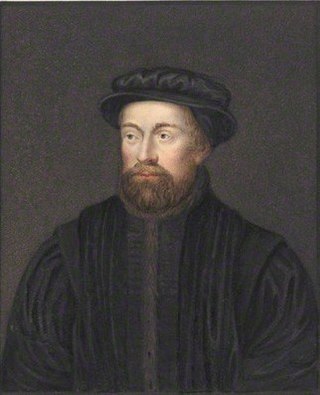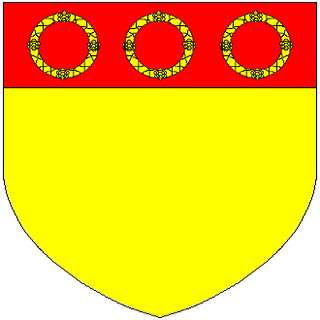Related Research Articles

Edward Fiennes, or Clinton, 1st Earl of Lincoln KG was an English landowner, peer, and Lord High Admiral. He rendered valuable service to four of the Tudor monarchs.

Sir John Baker was an English politician. He served as Chancellor of the Exchequer from 1545 to his death, having previously been Speaker of the House of Commons of England.

John Hales was a writer, administrator, and member of parliament during the Tudor period.
Sir Edward Saunders was an English judge and Chief Justice of the Queen's Bench.

Sir John Port was an English landowner and Knight of the Order of the Bath who served occasionally in the House of Commons. He was High Sheriff of Derbyshire in 1554. By his will, he founded Repton School and almshouses at Etwall. He also owned Caverswall Castle from 1531 after acquiring it through marriage to Elizabeth.
Walter Hungerford, 1st Baron Hungerford of Heytesbury, was created Baron Hungerford of Heytesbury in 1536.
John Sackville MP was a member of parliament for East Grinstead, and a local administrator in Essex, Sussex and Surrey. His first wife was Margaret Boleyn, an aunt of Henry VIII's second Queen, Anne Boleyn, and a great-aunt of Queen Elizabeth I.

Sir John Lyttelton was an English nobleman, politician, knight, and landowner from the Lyttelton family during the Tudor period.

Sir Richard Morrison was an English humanist scholar and diplomat. He was a protégé of Thomas Cromwell, propagandist for Henry VIII, and then ambassador to the German court of Charles V for Edward VI.
Sir Edward Hales, 1st Baronet (1576–1654) was an English politician who sat in the House of Commons in various years between 1605 and 1648. He supported the Parliamentarian side in the English Civil War.
Sir John Pakington, was Chirographer of the Court of Common Pleas, a Member of Parliament for Gloucester, and Sheriff of Herefordshire and Worcestershire. In 1529 he received an extraordinary grant from Henry VIII permitting him to wear his hat in the King's presence.

Sir Edmund Walsingham of Scadbury Hall, Chislehurst in Kent, was a soldier, Member of Parliament, and Lieutenant of the Tower of London during the reign of King Henry VIII.

John Hales, of The Dungeon in the parish of St. Mary Bredin, Canterbury, Kent, was an administrator, politician and judge who was appointed a Baron of the Exchequer in 1522.
Thomas Hales, of Thanington, near Canterbury, Kent, was an English politician.
Thomas Browne, of Betchworth Castle, Surrey, was an English politician.

Sir James Hales was an English judge from Kent, the son of the politician and judge John Hales. Though a Protestant, he refused to seal the document settling the crown on the Protestant claimant Lady Jane Grey in 1553, and during the following reign of the Catholic Queen Mary opposed the relaxation of the laws against religious nonconformity. Imprisoned for his lack of sympathy to Catholicism and subjected to intense pressure to convert, in a disturbed state of mind he committed suicide by drowning. The resulting lawsuit of Hales v. Petit is considered to be a source of the gravediggers' dialogue after Ophelia drowns herself in Shakespeare's play Hamlet.
Sir Christopher More was an English administrator, landowner, and Member of Parliament. More was the son of John More, a London fishmonger, and his wife, Elizabeth. He was active in local administration in Sussex and Surrey, and from 1505 until his death held office in the Exchequer, rising in 1542 to the post of King's Remembrancer. His sister, Alice More, was the fourth wife of Sir John More, father of Sir Thomas More.
Dorothy Kitson, later Dorothy, Lady Pakington, was the daughter of Sir Thomas Kitson, a wealthy London merchant and the builder of Hengrave Hall in Suffolk. Her first husband was Sir Thomas Pakington, by whom she was the mother of Queen Elizabeth I's favourite, Sir John "Lusty" Pakington. After Sir Thomas Pakington's death, she married Thomas Tasburgh. She was one of the few women in Tudor England to nominate burgesses to Parliament and to make her last will while her husband, Thomas Tasburgh, was still living. Her three nieces are referred to in the poems of Edmund Spenser.
Margaret Bourchier, Countess of Bath was an English Tudor noblewoman. She is notable for the three high-profile and advantageous marriages she secured during her lifetime, and for her success in arranging socially impressive marriages for many of her children. Through her descendants she is a common ancestor of many of the noble families of England.
Sir John Spelman was an English judge from Norfolk, noted for his composition of law reports.
References
- Baker, J.H. (2004). Hales, Sir Christopher (d. 1541). Oxford Dictionary of National Biography . Retrieved 17 January 2013.(subscription required)
- Baker, J.H. (2008). Hales, John (1469/70–1540?). Oxford Dictionary of National Biography . Retrieved 4 January 2013.(subscription required)
- Burke, John and John Bernard Burke (1838). A Genealogical and Heraldic History of the Extinct and Dormant Baronetcies of England. London: Scott, Webster and Geary. p. 232. Retrieved 9 January 2013.
- Foss, Edward (1857). The Judges of England. Vol. V. London: Longman Brown. pp. 183–4. Retrieved 20 January 2013.
- Hales, R. Cox (1882). "Brief notes on the Hales Family". Archaeologia Cantiana. XIV. London: Kent Archaeological Society: 61–84. Retrieved 4 January 2013.

-
 Works related to Christopher Hales at Wikisource: Dictionary of National Biography, 1885–1900, Volume 24, pp. 26–7.
Works related to Christopher Hales at Wikisource: Dictionary of National Biography, 1885–1900, Volume 24, pp. 26–7.
- Attribution
This article incorporates text from Foss's Judges of England, a publication now in the public domain.
